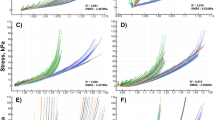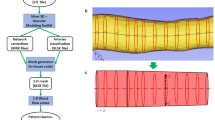Abstract
A model of the human arterial system was constructed based on the anatomical branching structure of the arterial tree. Arteries were divided into segments represented by uniform thin-walled elastic tubes with realistic arterial dimensions and wall properties. The configuration contains 128 segments accounting for all the central vessels and major peripheral arteries supplying the extremities including vessels of the order of 2·0 mm diameter. Vascular impedance and pressure and flow waveforms were determined at various locations in the system and good agreement was found with experimental measurements. Use of the model is illustrated in investigating wave propagation in the arterial system and in simulation of arterial dynamics in such pathological conditions as arteriosclerosis and presence of a stenosis in the femoral artery.
Similar content being viewed by others
Abbreviations
- ϱ:
-
blood density
- co :
-
pulse wave velocity
- σ:
-
Poisson ratio for arterial wall
- F 10 :
-
the expression\(\frac{{2J_1 \left( {\alpha j^{{3 \mathord{\left/ {\vphantom {3 2}} \right. \kern-\nulldelimiterspace} 2}} } \right)}}{{\alpha j^{{3 \mathord{\left/ {\vphantom {3 2}} \right. \kern-\nulldelimiterspace} 2}} J_0 \left( {\alpha j^{{3 \mathord{\left/ {\vphantom {3 2}} \right. \kern-\nulldelimiterspace} 2}} } \right)}}\). whereJ 0 andJ 1 are Bessel functions of the first kind, and order zero and one, respectively, and\(\alpha = R_0 \sqrt {{{\omega \rho } \mathord{\left/ {\vphantom {{\omega \rho } \mu }} \right. \kern-\nulldelimiterspace} \mu }} \)
- λ:
-
propagation constant
- ω:
-
angular frequency
- E :
-
Young's modulus of arterial wall
- h :
-
wall thickness
- R 0 :
-
internal radius of arterial segment
- ηw :
-
viscoelasticity of the arterial wall
- Γ:
-
reflection coefficient
- μ:
-
blood viscosity
References
Avolio, A. P., O'Rourke, M. F., Mang, K., Bason, P. andGow, B. S. (1976) A comparative study of pulsatile arterial hemodynamics in rabbits and guinea pigs.Amer. J. Physiol. 230, 868.
Bergel, D. H. (1961) The dynamic elastic properties of the arterial wall.J. Physiol. 156, 458
Frank, O., (1899) Die Grundfurm des artiriellen Puls.Zeitschrift fur Biologie. 37, 483
Gupta, T. C. andWiggers, C. J., (1951) Basic hemodynamic changes produced by aortic coarctation in different degrees.Circ. 3, 17
Hales, S., (1733) ‘Haemastatiks’, Hafner Publishing Co., London.
Hardung, V. (1962) Propagation of pulse waves in viscoelastic tubings.In W. F. Hamilton andP. Dows (eds)Handbook of Physiology, Circulation Vol. 1, Amer. Physiol. Soc.
Jager, G. N., Westerhof, N., andNoordergraaf, A. (1965) Oscillatory flow impedance in an electrical analog of the arterial system: representation of sleeve effect and non-newtonian properties of blood.Circ. Res. 26, 121
Little, J. M., Sheil, A. G. R., Loewenthal, J. andGoodman, A. H. (1968) Prognostic value of intraoperative blood flow measurements in femoropopliteal bypass vein grafts.The Lancet,2, 648
McDonald, D. A. (1974) ‘Blood flow in Arteries’, (Arnold, London, 2nd edn.)
Mills, C. J., Gabe, I. T., Gault, J. H., Mason, P. T., Ross, J., Braunwald, E. andShillingford, J. P., (1970) Pressure-Flow relationships and vascular impedance in man.Cardiovasc. Res. 4, 405
Noordergraaf, A., Verdouw, P. D. andBoom, H. B. C. (1963) The use of an analog computer in a circulation model.Prog. Card. Diseases 5, 419
O'Rourke, M. F. (1965) ‘Pressure and flow in arteries’ M.D. Thesis, University of Sydney
O'Rourke, M. E., andTaylor, M. G., (1966) Vascular impedance of the femoral bed.Circ. Res. 18: 126
O'Rourke, M. E., (1967) Pressure and flow waves in systemic arteries and the anatomical design of the arterial system.J. Appl. Physiol. 23, 139.
Rideout, V. C. andDick, D. E., (1967) Differencedifferential equations for fluid flow in distensible tubes.IEEE Trans, Biomed, Eng. BME-14, 171.
Taylor, M. G., (1959) The experimental determination of the propagation of fluid oscillations in a tube with a viscoelastic wall; tobether with an analysis of the characteristics required in an electrical analogue.Phys. Med. Biol. 4, 63
Taylor, M. G., (1966) The input impedance of an assembly of randomly branching elastic tubes.Biophys. J 6, 29
Westerhof, N. andNoordergraf, A., (1970) Arterial viscoelasticity: a generalised model.J. Biomech. 3, 357
Womersley, J. R. (1957) The mathematical analysis of the arterial circulation in a state of oscillatory motion. Wright Air Development Centre, Technical Report. WADC-TR56-614
Young, D. F., Cholvin, N. R., Roth, A. C. (1975): Pressure drop across artificially induced stenosis in the femoral arteries of dogs.Circ. Res. 36, 735.
Author information
Authors and Affiliations
Rights and permissions
About this article
Cite this article
Avolio, A.P. Multi-branched model of the human arterial system. Med. Biol. Eng. Comput. 18, 709–718 (1980). https://doi.org/10.1007/BF02441895
Received:
Accepted:
Issue Date:
DOI: https://doi.org/10.1007/BF02441895




